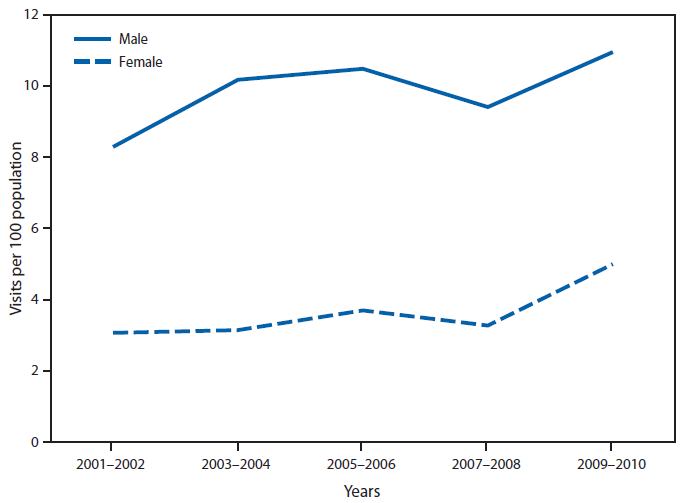Persons using assistive technology might not be able to fully access information in this file. For assistance, please send e-mail to: mmwrq@cdc.gov. Type 508 Accommodation and the title of the report in the subject line of e-mail.
QuickStats: Rate of Ambulatory-Care Visits* for Attention Deficit Hyperactivity Disorder (ADHD)† by Persons Aged ≤18 Years, by Sex — United States, 2001–2002 to 2009–2010

* Visits to hospital outpatient departments and physician offices per 100 population. Rates were calculated using U.S. Census Bureau 2000–based postcensal civilian population estimates.
† Defined as having a first-listed diagnosis of 314.00 or 314.01, as coded according to the International Classification of Diseases, Ninth Revision, Clinical Modification.
From 2001–2002 to 2009–2010, the ambulatory-care visit rate for ADHD for females aged ≤18 years increased by 63%, from 3.1 to 5.0 visits per 100 population. Over the same period, the change in the visit rate for males did not follow a consistent pattern; in 2009–2010, the visit rate for males was 11.0 per 100. Throughout the period, males were more likely than females to have an ambulatory-care visit for ADHD.
Sources: National Ambulatory Medical Care Survey 2001–2010. Available at http://www.cdc.gov/nchs/ahcd.htm.
Reported by: Michael Albert, MD, wmy1@cdc.gov, 301-458-4223; Jill J. Ashman, PhD.
Alternate Text: From 2001-2002 to 2009-2010, the ambulatory care visit rate for attention deficit hyperactivity disorder (ADHD) (defined as having a first-listed diagnosis of 314.00 or 314.01, as coded according to the International Classification of Diseases, Ninth Revision, Clinical Modification) for females aged ≤18 years increased by 63%, from 3.1 to 5.0 visits per 100 population. Over the same period, the change in the visit rate for males did not follow a consistent pattern; in 2009-2010 the visit rate for males was 11.0 per 100. Throughout the period, males were more likely than females to have an ambulatory care visit for ADHD.
Use of trade names and commercial sources is for identification only and does not imply endorsement by the U.S. Department of
Health and Human Services.
References to non-CDC sites on the Internet are
provided as a service to MMWR readers and do not constitute or imply
endorsement of these organizations or their programs by CDC or the U.S.
Department of Health and Human Services. CDC is not responsible for the content
of pages found at these sites. URL addresses listed in MMWR were current as of
the date of publication.
All MMWR HTML versions of articles are electronic conversions from typeset documents.
This conversion might result in character translation or format errors in the HTML version.
Users are referred to the electronic PDF version (http://www.cdc.gov/mmwr)
and/or the original MMWR paper copy for printable versions of official text, figures, and tables.
An original paper copy of this issue can be obtained from the Superintendent of Documents, U.S.
Government Printing Office (GPO), Washington, DC 20402-9371;
telephone: (202) 512-1800. Contact GPO for current prices.
**Questions or messages regarding errors in formatting should be addressed to
mmwrq@cdc.gov.
 ShareCompartir
ShareCompartir


